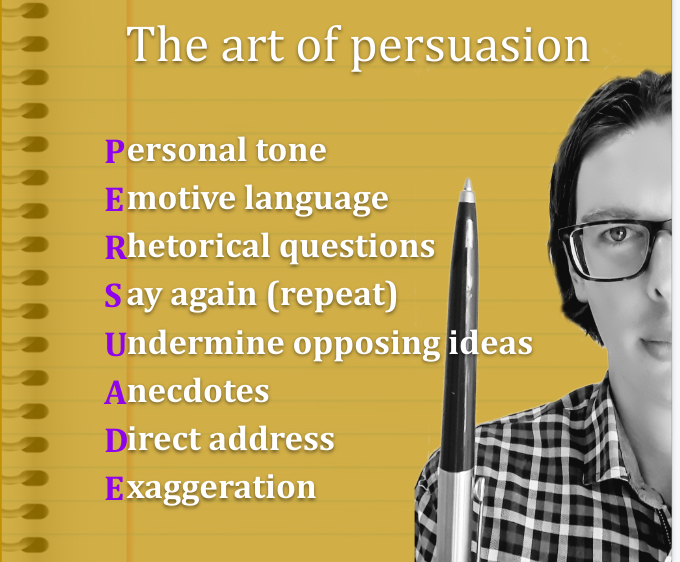Writing With a Precise Purpose Ensures Your Work Hits the Mark

What am I trying to achieve with this writing?
This is perhaps the most important question to ask yourself before you start typing. Do you set a clear intention to inform, entertain or explain when crafting new writing?
Nowadays, there is inexhaustible content available for readers. That means you’ll have to work hard to motivate people with your words (but not so hard that the readers notice what you’re doing).
Although persuading and inspiring both use rhetorical techniques, the desired outcome is not the same. These are quite different purposes.
Writing to Persuade

Persuasion is about changing a view or opinion. Views and opinions are something personal, and our reasons for holding them can differ. By successfully persuading, writers adapt, induce or break a belief through reasoning or argument. Now, this might cause readers to take action, but there will likely be several steps before they do that.
Rather than explain the process of persuasive writing, allow me to demonstrate with a passage designed to persuade executives that writing courses should be covered by corporate training budgets:
“Do you spend the majority of your day writing emails? Most office-based (and remote) jobs require you to spend a huge amount of time constructing and formatting text to facilitate effective communication.
Yes, we receive some basic writing instruction at school, but if the success of your job hinges on writing, it’s crazy that you don’t get bespoke training to improve this essential skill. We all need help on how to use rhetorical and literary techniques, so our words shine through and portray the message we want. You might think that soft skills like writing shouldn’t fall under the remit of company training, but it’s only because the improvements can’t be measured numerically. They can easily be measured in terms of better client relationships and decreased misunderstandings.
By learning the techniques to persuade, communicate, and inspire, staff will become mega-effective at their job. They will maintain relationships, win new business, and prove the worth of their brilliant work.
All you have to do to demonstrate the results is to keep notes. Maintain a record of your old writing. Show your bosses how much better it is now. Ask your clients and suppliers to write a testimonial demonstrating that your emails and reports are helpful and effective.
That’s why I think employers should consider the massive benefits of writing courses. With a team of star writers, their business will be in great shape for the future.”
(Philip Charter, on why companies should pay him more).
Are you convinced about the need for writing training? I hope so.
Here are some of the persuasive techniques I used:
- Addressing the reader (you, your).
- Ungradable adjectives (massive, mega-effective, crazy, essential, huge).
- Imagery (shine through, brilliant, star).
- Rule of three (e.g. “persuade, communicate, and inspire”).
- Rhetorical questions (“Do you spend the majority of your day writing emails?”).
- Objection handling (“You might think that soft skills like writing shouldn’t fall under the remit of company training, but it’s only because the improvements can’t be measured numerically”).
Objection handling, especially, is underused in persuasive writing. Whether you are writing an op-ed article or an angry social media post, it’s a decent idea to consider the opposing opinion. What objections might readers have to your argument? Now show why those objections aren’t valid. It’s an incredibly powerful tool.
How can you persuade the reader?

This is not an exhaustive list of persuasive devices. The key is to select a variety of techniques to include in your emails, sales materials, and web copy.
If you rely on just one or two strategies, your readers will pick up on this.
And of course, less is more. You don’t want to stuff every technique you know into your writing. Trying too hard will show your hand to the reader. (My example is possibly ‘trying too hard’, but I wanted to demonstrate the techniques.)
Getting the persuasive frequency right is something that requires analysis of effective text and help from experienced readers and writers.
Writing to Inspire

So now we know how to change minds. It’s time to win readers’ hearts. To inspire means to fill readers with the urge to do something (that’s not an obligation). Writers enable people to take action by inspiring them to do or feel something. And action often comes from emotion rather than reason.
I’m not just talking about cheesy copywriting (BUY NOW, or you’ll regret it!!!). Inspiring readers is simply motivating them to take action, which is not a must. This can be to getting people to volunteer for a project at work, requesting donations for your charity drive, or asking readers to join your community.
Typically, marketing copy attempts to motivate the reader to take action by playing on their fears (e.g. “Never miss another Polaroid moment”). Negatives like ‘never’, ‘don’t’, and ‘won’t’ instil more urgency in readers, but writers should be careful of overusing this technique. As with persuasive techniques, it becomes obvious quite quickly. Readers are bombarded with marketing messages, so play on their fears only if it’s appropriate.
Another technique straight from the advertising playbook is using emotive adjectives and more impactful verbs. Consider the difference:
- ‘Bright and sparkling glasses’ OR ‘Dazzling cut-crystal glasses’?
- ‘Want to start a business?’ OR ‘Want to launch your own business?’
- ‘Become a leading brand’ Or ‘Dominate the competition’?
These emotive adjectives and extreme verbs can tap into a host of feelings: the need for safety, the desire for authority, anger, confusion, greed, vanity, laziness, lust, curiosity, and more. ‘Extreme’ verbs are ones which describe actions which are quicker, bigger, or more exciting (e.g. ‘grab’ instead of ‘take’ or ‘sprint’ instead of ‘run’). Power Thesaurus is a good resource for upgrading the emotive impact of your vocabulary.
Charity campaigns and blog posts from NGOs often use a different technique to inspire — stories. Great stories give the campaign a face and tell you how their fundraising changed the life of a real person. They describe the smile that followed the pain. They expose the ‘before’ and ‘after’. Stories work because somewhere in the text, a change has to take place. That’s what provides the idea that we, as readers, can change and take action.
Rather than speaking directly to the reader (as persuasive pieces do), inspirational writing uses the first person plural — ‘we’, ‘us’, and ‘our’. What’s more likely to drive action, ‘you should help end child poverty’ or ‘let’s work together to end child poverty by 2025'?
One of the most motivational and inspiring examples I can cite (it still makes me tear up) is Al Pacino’s halftime speech in the film Any Given Sunday:
“The inches we need are everywhere around us.
They’re in every break of the game, every minute, every second.
On this team, we fight for that inch. On this team, we tear ourselves and everyone else around us to pieces for that inch. We claw with our fingernails for that inch, because we know when we add up all those inches that’s gonna make the f***ing’ difference between winning and losing!” Tony D’Amato, Any Given Sunday.
There is some effective repetition here, especially in the sentences which use the first-person plural. This drives the home idea that the team needs to work together and fight for every inch.
One final technique to inspire readers is to use imperatives. Keep calls to action clear and offer a simple decision to the readers. Which button are you most likely to click?
- “If you want to download the writing guide, you should visit my website” OR
- “Get your FREE writing guide here.”
How can you inspire the reader?
Focus on one or two of these methods to inspire action.
- Use negatives and harness readers’ fears.
- Employ emotive adjectives and extreme verbs.
- Include stories in your writing.
- Use the first person plural (we, us, our).
- Keep instructions simple. Use imperatives.
- Add impact through repetition.
The real difference between persuading and inspiring your reader is how many techniques you can use. Of course, it’s possible to employ some of these ‘inspirational’ techniques together. However, these methods are often more powerful if limited. This allows you to build the emotion and increase the effect of your use of fear/stories/first person plural etc., to get the reader to really FEEL the power of your words.
When they do, and only when they do, they will take action.
Summing Up
There you have it. Writing to persuade and writing to inspire may use many of the same techniques, but they are fundamentally different.
Ensure your text has a clear purpose. The tighter your focus on either persuading or inspiring the reader, the more likely you are to succeed.
Now go forth and persuade (or inspire)!

Philip Charter is a writing coach from the UK who works with multilingual content writers. He is also the author of two collections of short fiction and Fifteen Brief Moments in Time, a novella-in-flash.
If you found this useful, please check out his other articles or connect on LinkedIn.
